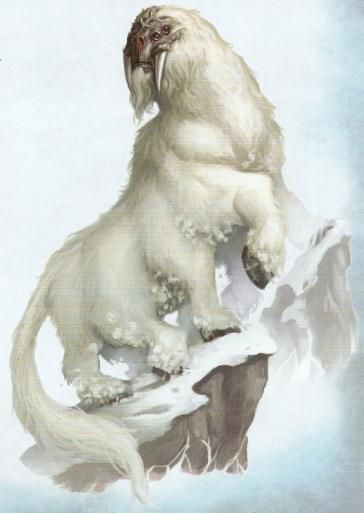Wollipeds
This shaggy, multi-legged creature has a flattened face with wide nostrils and four eyes. Ivory tusks jut downward, flanking its mouth.
Basic Information
Genetics and Reproduction
Wollipeds live for about 15 years, mating and giving birth every 11 months, and can be ridden until the final month of pregnancy.
Ecology and Habitats
Walking on eight sturdy legs, wollipeds are exceptionally sure-footed. These creatures can climb steep mountain trails and march through heavy snow with little effort, and arctic cavalry have often charged up scree-choked hillsides to raid fortresses on the backs of armored wollipeds. The great beasts’ facility at maneuvering in challenging environments, as well as their generally submissive nature, have resulted in a long relationship with the humanoids that share their homes.
Dietary Needs and Habits
Wollipeds are social herd animals that subsist on a diet of grasses, leaves, and other plant material. Wollipeds in high mountainous environments obtain much of their food from lichens and mosses, while herds of wollipeds on the plains graze on more substantial fare. Wild wollipeds tend to migrate to more plentiful foraging lands in the harshest winters, though these can be difficult to find.
Additional Information
Social Structure
Wollipeds are social animals, grouping together into herds for protection. When threatened, wollipeds gather in a tight cluster with the young animals in the very center of the herd. Domesticated wollipeds are used for casual riding, pulling plows, and powering mills.
Wollipeds are known to use spitting as a form of communication, as well as a method of defense. Most wollipeds only spit at one another, typically in the course of their tusk-clashing shows of dominance, but when threatened, they can launch a nauseating wad of partially digested food at their attackers to sicken and distract them.
Domestication
Some claim wollipeds weren’t initially domesticated to be working animals, but rather were herded and bred for their extremely warm and plentiful fleece. Regardless of the creatures’ origins, arctic dwellers have a long history of using these magnificent animals for many purposes, even employing them as mounts in battle.
Uses, Products & Exploitation
Wolliped fleece is a versatile textile, as wolliped fibers wick water away, and still provide adequate warmth even when soaked. The variations in their coat colors and textures provide weavers with a wide array of design options.
Geographic Origin and Distribution
Wollipeds only live at Fjornandes and the north of Crestiennet.
Lifespan
15 years
Average Height
5 and 6 feet at the front shoulder
Average Weight
1,000 pounds
Remove these ads. Join the Worldbuilders Guild









Comments